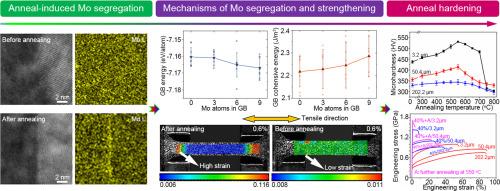Microstructural analysis and its correlation to anneal hardening in a cobalt-nickel-based superalloy
IF 8.3
1区 材料科学
Q1 MATERIALS SCIENCE, MULTIDISCIPLINARY
引用次数: 0
Abstract
Anneal hardening has been commonly observed in single-phase solid solutions, including face-centered cubic (FCC) alloys containing transitional-metal elements. However, the underlying mechanisms governing this effect have remained unclear due to a lack of direct evidence. In this study, we utilize multi-scale in-situ characterizations to thoroughly investigate the microstructural evolution during annealing of an MP35 N (Co35Ni35Cr24Mo6, at %) alloy. Our findings reveal negligible differences in the crystal structure, grain boundary (GB) character, and dislocation structure before and after annealing at 550 °C. However, in-situ transmission electron microscopy heating experiments and atomic-resolution energy-dispersive spectroscopy mappings disclose that the 550 °C annealing promotes nanoscale segregation of Mo into GBs, driven by the reduced GB energy. These segregated Mo atoms engage in strong charge exchanges with neighboring atoms, enhancing the GB's cohesive strength and improving the resistance to dislocation motion due to the increased strain field near the GBs. Consequently, the GB strengthening effect is enhanced, leading to significant anneal hardening in the fine-grained sample (3.2 μm) with Mo segregation, while no hardening is observed in the coarse-grained sample (202.2 μm) lacking Mo segregation. Furthermore, we demonstrate that annealing at higher temperatures triggers an interfacial phase transition from the FCC to a μ phase through spinodal decomposition accompanied by significant dislocation recovery, which paradoxically weakens the anneal hardening effect. These findings provide deeper insights into the anneal hardening phenomena and offer valuable guidance for optimizing cold working and heat treatment processes in the further development of high-performance structural alloys.


钴镍基高温合金的显微组织分析及其与退火硬化的关系
退火硬化在单相固溶体中很常见,包括含有过渡金属元素的面心立方(FCC)合金。然而,由于缺乏直接证据,控制这种效应的潜在机制仍然不清楚。在本研究中,我们利用多尺度原位表征来深入研究MP35N (Co35Ni35Cr24Mo6, at.%)合金在退火过程中的组织演变。我们的研究结果表明,550℃退火前后的晶体结构、晶界(GB)特征和位错结构的差异可以忽略不计。然而,原位透射电镜加热实验和原子分辨率能量色散光谱映射表明,550℃退火促进了Mo向GB的纳米级偏析,这是由GB能量降低所驱动的。这些分离的Mo原子与邻近原子进行强电荷交换,提高了GB的内聚强度,并由于GB附近应变场的增加而提高了对位错运动的抵抗力。结果表明,存在Mo偏析的细晶(3.2 μm)试样存在明显的退火硬化,而不存在Mo偏析的粗晶(202.2 μm)试样则没有发生退火硬化。此外,我们还发现,高温退火触发了界面相从FCC到μ相的转变,并伴有明显的位错恢复,这反而削弱了退火硬化效应。这些发现为进一步研究退火硬化现象提供了更深入的见解,并为进一步开发高性能结构合金优化冷加工和热处理工艺提供了有价值的指导。
本文章由计算机程序翻译,如有差异,请以英文原文为准。
求助全文
约1分钟内获得全文
求助全文
来源期刊

Acta Materialia
工程技术-材料科学:综合
CiteScore
16.10
自引率
8.50%
发文量
801
审稿时长
53 days
期刊介绍:
Acta Materialia serves as a platform for publishing full-length, original papers and commissioned overviews that contribute to a profound understanding of the correlation between the processing, structure, and properties of inorganic materials. The journal seeks papers with high impact potential or those that significantly propel the field forward. The scope includes the atomic and molecular arrangements, chemical and electronic structures, and microstructure of materials, focusing on their mechanical or functional behavior across all length scales, including nanostructures.
 求助内容:
求助内容: 应助结果提醒方式:
应助结果提醒方式:


